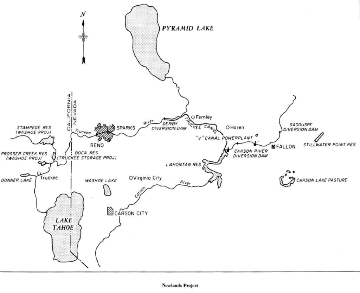 | Click Here for a PDF (printer friendly) version |
Is it any wonder why the Newlands Project was selected by the staff of the Geological Survey, considering the National Reclamation Act was sponsored by Nevada's congressman, Francis Newlands and the work already done in the state by government and private engineers? Even though the money available from Nevada's reclamation fund was the smallest of all the western states and territories, the need was great. At the turn of the century, farmers irrigated approximately 500,000 acres throughout the state, but the potential was limited because a few settlers and cattlemen controlled much of the land around the water sources. The Humboldt, Truckee, Carson, and Walker streams provided most of the water during the winter months, but water storage was necessary for the reclamation of the desert lands year round.[1]
As early as 1860, ranchers arrived in the Lahontan Valley in northwestern Nevada and gradually started to farm, with cultivated land reaching 5,000 acres by 1880. The Powell Irrigation Survey examined the resources in Nevada, indicating that the Truckee River could be diverted through a canal to the Lahontan Valley, but beyond this study no viable action was taken. At approximately the same time, Francis G. Newlands, son-in-law and trustee of the William Sharon estate which held extensive acreage in Nevada, moved to Carson City and started to acquire his own land along the Truckee River in 1889. Newlands expanded his holdings and commissioned surveying parties to examine reservoir and canal sites; the entrepreneur also used reclamation as an issue in his bid for political office. Betweenl899 and 1900, L. H. Taylor, an engineer and director of the University of Nevada Agricultural Experiment Station, investigated a number of reservoir locations and after the passage of the Reclamation Act, surveyed additional sites, including those along the Carson and Truckee rivers. Rainfall in the Carson Sink Valley averaged approximately six inches a year, not enough to provide a stable water supply without the construction of storage reservoirs.[2]
The initial irrigation structures of the project designed by the reclamation engineers included the earthen Derby Diversion Dam on the Truckee River, the thirty-one-mile Truckee Canal, with a carrying capacity of 1,200 to 1,500 second feet, the Carson River Diversion Dam and a distribution system of canals and laterals carrying water to the farm units. The original plan for a storage dam on Lake Tahoe was halted by the property owners along the lake fearing the water levels would fluctuate greatly, so federal engineers constructed the Lahontan Dam and Reservoir in 1911. A legal settlement was finally reached with the Truckee River General Electric Company concerning storage of water at Lake Tahoe and the federal engineers proceeded with construction of a dam on the lake. As part of its work to insure the productivity of the lands, the Reclamation Service constructed a network of drainage ditches to prevent alkali damage to the land and crops from the rising groundwater level.[3]
With the designation of the Newlands project as one of the first projects, changes occurred that could only happen when enough water is available. Prior to its selection as a reclamation project, Churchill County, being the slowest growing county in the state, contained only 830 people within 4,883 square miles, but within ten years, Fallon, the county seat, boasted a population of 1,000 people alone in 1913. The community, which had originally served as a supply depot for the nearby mining districts, experienced real growth and a building boom. The town increased in size from those working on the reclamation structures, to supplying the engineers with needed livestock and equipment, to new homesteaders eager to farm the land with the developed water; by 1926, Fallon's residents doubled to 2,000. Residents of Fallon were supplied electricity produced by the Lahontan hydropower plant under contract to the city by the Reclamation Service. The system had grown to such an extent that eighty-five percent of possible customers were receiving power from the reclamation project.[4]
By the mid-1920s, alfalfa was the principal crop, still providing for the original livestock industries focused on cattle, sheep, and hogs, while dairy farms started to make an ever growing appearance in the region. Farmers also grew wheat, barley, potatoes, sugar beets and garden truck with celery and cantaloupes harvested for commercial businesses. With the assurance of a stable water supply for growing sugar beets, the Hinze Brothers of California organized the Nevada Sugar Company in 1910 and opened a factory in the center of Fallon, providing new opportunities for the farmers and factory workers.[5]
The acreage on the Newlands Project encompassed over 200,000 acres and boosters, including the Central and Southern Pacific Railways which owned approximately 10,000 acres, expected to have all that land farmed. Within ten years of the selection of the Newlands Project, however, farmers irrigated just 43,000 acres and that amount increased to only 45,000 a decade later despite water right applications having been filed for 70,000 acres in 1923. While at least half the farm land held was in private ownership, the remaining public lands were open tohomestead entry, providing opportunities for new settlers.[6]
